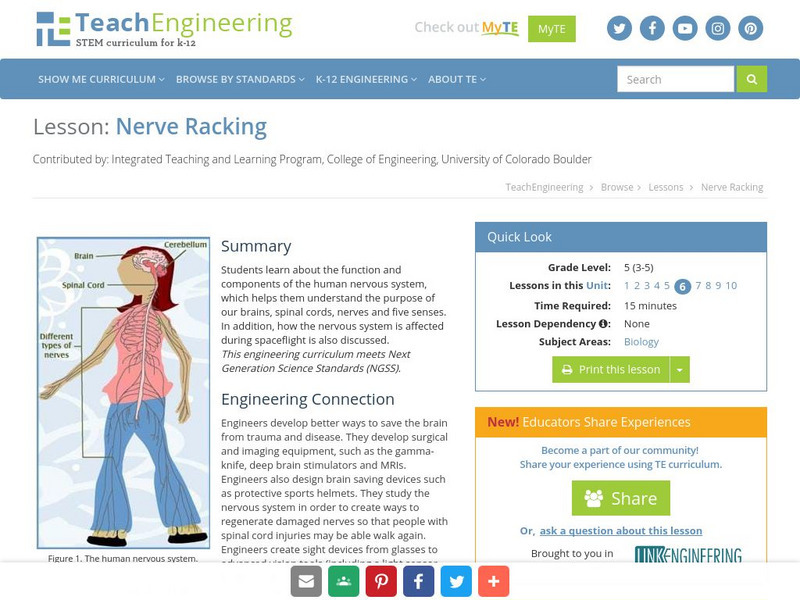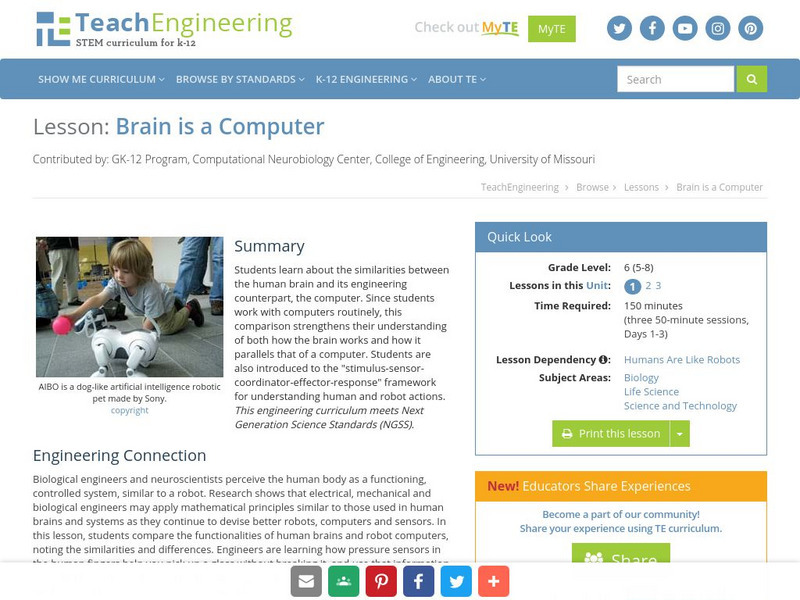Hi, what do you want to do?
Curated OER
The Laughing Brain 1: How We Laugh
Learners to rate themselves on a scale from 1 to 10 (10 being the happiest) as to how happy they feel and write their rating on a sheet of paper. They explore gelotology (the science of laughter) and its benefits to our social, mental,...
Curated OER
How We Learn About the Brain: Teaching the Infant Brain
Students describe the development of an infant from conception to birth. In this biology instructional activity, students discover how a child's brain develop. They explain how children acquire motor and cognitive skills.
Curated OER
The Drug Connection: Design-O-Synapse
High schoolers study cholinergic neuromuscular pathway of acetylcholine release and develop a model for drug interaction at one specific neurological site. Working in teams, students can also research different drugs or poisons and...
Curated OER
Alcohol and Its Impact on the Brain
Students examine water as it changes states. In water and ice lesson students study the water cycle and what happens to it as it changes state.
Curated OER
All About the Brain
Students use eggs, cooking oil, foam balls and more to create a simulation of the brain and record what happens in each step. In this brain lesson plan, students learn about protecting the brain, the brain's ability to learn, and reflexes.
Curated OER
U.S. History: Our Constitutional Amendments
Eighth graders conduct Internet research about Constitutional Amendments and present oral reports on their findings. Their reports also include visual representations depicting their chosen amendment's focal point. Students discuss the...
Curated OER
Left and Right Brains
Students research the part of the brain known as the corpus callosum. The part of the brain that connects the left and right brain, students investigate its functions and how data passes from one side to another.
Curated OER
Mercury Emissions: "Cap and Trade" Game
Young scholars identify the role of government in protecting the environment, and participate in a game where they run a profitable or unprofitable power plant in changing market conditions. They summarize the pros and cons of emissions...
Curated OER
Sleep Disorders
Students reach sleep, dreaming and sleep walking. They research these topics at the provide web links as they read through the narrative and questions.
Curated OER
Hold Off on the Headphones
Students determine that waves carry energy and information from one place to another. They determine that wavelength, frequency and wave speed are related and describe that sound is a longitudinal wave whose speed depends on the...
Curated OER
Hold Off on the Headphones
Students explore hearing loss caused by sound waves. In this physical science lesson plan, students will start by learning about waves and wave characteristics and move into sound waves. Students will study how sound effects their...
Curated OER
Show 303: New Research into Dyslexia
Learners explore the causes of dyslexia. They view CT sans and MRIs to view the brain and how it responds. Students read reports about dyslexia. They discuss the nature of dyslexia, its cause, how to diagnose it, and its permanency.
Curated OER
Shells
Sixth graders label diagrams of the 6 different classes of mollusks and explain the meaning of the labeled terms. They identify 8 common New Haven shells. They organize their own shell collection during this series of lessons.
Curated OER
Alcohol and Pregnancy Don't Mix!
Seventh graders learn about John Kellerman, a youngster who was born with Fetal Alcohol Syndrome. They learn how alcohol and pregnancy doesn't mix.
Curated OER
This Stuff Makes Me Sick
Students participate in a lab showing the effects of pesticides on Lumbriculus variegatus. Several extensions and variations are also included in this lesson including one which relates the experiment to how pesticides enter our drinking...
Curated OER
You Won't Believe Your Eyes!
Middle schoolers gain a basic understanding of the sense of sight. They watch a video on sight, then engage in some vocabulary games, and perform some simple experiments which focus on the basics of sight.
Curated OER
Are You Being Poisoned by Your Dishes?
Students explore lead poisoning and how it relates to ceramic dishes. They perform an experiment to discover if any of your ceramic ware is leaching lead which might cause lead poisoning.
Curated OER
Lead Poisoning and Ceramic Dishes
Students explore the amount of lead in ceramic plates through an experiment. Students determine if everyday dishware is leaching lead into food. They chart their results and discuss how much lead in ceramic dishware may cause lead...
Alabama Learning Exchange
Alex: Imaginary Journey Through a System of the Body
The young scholars will choose one of the systems of the human body, such as circulatory, respiratory, digestive, or nervous system, and imagine that they are inside it. They will write a description of what a journey through this system...
TeachEngineering
Teach Engineering: Nerve Racking
This lesson describes the function and components of the human nervous system. It helps students understand the purpose of our brain, spinal cord, nerves and the five senses. How the nervous system is affected during spaceflight is also...
TeachEngineering
Teach Engineering: Human and Robot Sensors
Students are provided with a rigorous background in human "sensors" (including information on the main five senses, sensor anatomies, and nervous system process) and their engineering equivalents, setting the stage for three associated...
PBS
Pbs Teachers: Changing Your Mind: Nerve Cell Infomercials
Build nerve cell models in cooperative groups, and articulate the structure and function of nerve cells to explore the nervous system. Describe specific elements of human physiology by "advertising" the nervous system in nerve cell...
TeachEngineering
Teach Engineering: Brain Is a Computer
Students learn about the similarities between the human brain and its engineering counterpart, the computer. Since students work with computers routinely, this comparison strengthens their understanding of both how the brain works and...




























